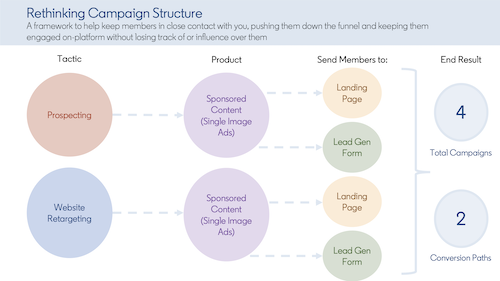3 Lasting Tenets for Higher Education Marketers
With the arrival of the new year, it’s a terrific time to take inventory of what did — and didn’t — work well for marketers in 2020. The good news is that people are online and engaging with content more than ever before. On LinkedIn alone, we’ve seen:
- Content shared across the platform was up almost 50% year-over-year
- 4X year-over-year increase in LinkedIn Learning hours watched
- 89% increase in live streams
This provides both an opportunity and a challenge for higher education marketers when it comes to breaking through the clutter. As a client solutions manager at LinkedIn working exclusively with higher education clients and leading a weekly data analysis of engaging creative on the platform, I’ve found a combination of ideal campaign structure and compelling content is an effective way to stand out. The key is to tie your creative and messaging to your campaign’s objectives – and the prospective student journey. By doing so, you can drive outstanding results.
Drive Impressive Results With the Right Campaign and Creative Structure
Recently, I worked with an established higher education institution to help them do just that.
The client’s primary objective was to drive program registrations – but they were seeing costs as high as $500-$1,000 per prospect. Knowing they could generate high-quality leads at a lower cost on the platform, the client asked me to evaluate their campaign structure and creative assets.
The issues making it difficult to deliver decent numbers were in large part structural; the campaigns only sent prospects to the program landing page and relied on video ads for acquisition. Based on my experience, I find better results occur when using single-image ads for direct response, and providing multiple avenues for conversion by sending prospects to program pages and using LinkedIn Lead Gen Forms.
First, I provided a template to reconfigure their campaign setup. This approach, which I recommend to all higher education marketers, makes it possible to stay in closer contact with prospective students along their journey:
This structure works whether it's a prospect’s first ad exposure or you’re re-engaging those who were interested and didn’t convert immediately, but now have a better understanding of the school’s program.
Next, I helped refocus their creative messaging to better resonate with their target audience – those seeking technical certification – and to be more aspirational and career-minded in tone. I embedded the price of the program within the image, and provided key information around time commitment and ROI. For the retargeting campaigns, I put greater emphasis on the program start date, and used “urgency” language to influence conversion.
The result was a 90% reduction in cost per acquisition and a $30-$40 cost per lead. To capitalize on the success, the client uploaded a list of all leads to drive enrollments and expanded their product mix to include Sponsored Message Ads, leveraging my creative best practices shared below.
3 Guiding Principles for Advertising that Work
It should inspire you to know that you don’t need to devise a completely novel advertising strategy. As the client example here shows, the key is to tap into three guiding principles that are core to every winning campaign.
1. Develop lasting and impactful creative
LinkedIn members are more than willing to invest in their education. According to a survey conducted with SimpsonScarborough, of the adults interested in additional education, LinkedIn members are more likely to be actively considering (77%), and more plan to enroll within six months (64%). You’re asking them to make a significant financial commitment – help assuage their concerns by showing them the return on their investment. Specifically, tout the salary they can expect after graduation or the growth trajectory in the specific field/career.
A few tips I have found to be successful are crafting copy and imagery that your target audience finds relatable, and emphasizing how your school can immediately help their careers, community, and collective well-being. A great way to do that is utilizing text overlays in your creative image. Make use of all the space to showcase your institution’s unique branding as well as provide more valuable information upfront to those ready to take the next step
2. Encourage conversion
According to research conducted with Ipsos, 75% of the new wave of students are in-market, the typical decision process for a prospective student to enroll can be 6 months to a year. Adopting a full-funnel strategy that lets you engage prospects over the long term can set you apart and keep you top of mind. A study from the Institute of Practitioners in Advertising shows that the optimal balance of brand and demand in both digital and traditional marketing is a 60/40 split: 60% branding, 40% direct response.
By continually exposing highly interested students to your story and messages, you capture interest, raise awareness and keep them close. According to LinkedIn data, higher Education marketers who leverage a multi-product strategy see a 24x increase to enrollment rate.
3. Nurture to enrollment
The work doesn’t end once you generate leads. Did you know that schools see 2X the enrollment rate when they message a prospective student 3+ times on LinkedIn after becoming a lead? Upload all of the leads you capture to LinkedIn and continue to message about open houses, fee waivers and application deadlines. I’ve seen this change the game in the form of incremental applications and enrollments off limited investment.
The greatest indicator of your advertising success is getting your target audience to take action. Underscore the key dates and deadlines they need to keep in mind on their journey to enrollment. Including key dates not only adds more urgency but makes your content appear much more timely.
Drive Impressive Results at All Times
No matter what the situation, certain advertising best practices prove effective when executed well. It’s a matter of engaging the target audience throughout their journey in a way that keeps them engaged and ultimately compels them to action. Higher education marketers who take advantage of these tried-and-true approaches on LinkedIn – where a majority of members are eager to pursue additional education – position their schools to better convert prospective students.
To learn more about creating compelling campaigns to reach prospective students, please contact your sales representative or visit our website.
To keep abreast of trends in Higher Education, subscribe to the LinkedIn Marketing Blog today.






